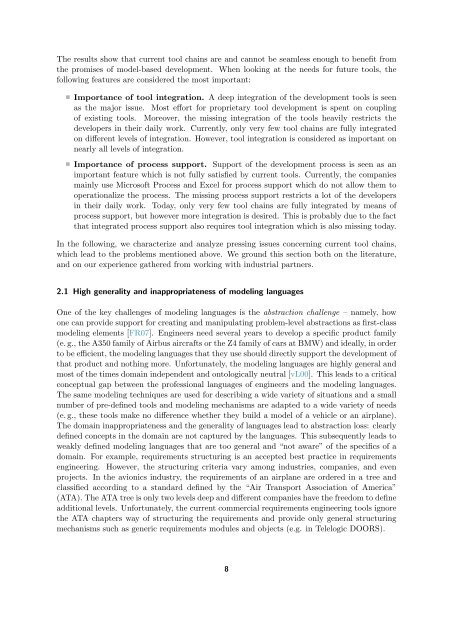SPES 2020 Deliverable 1.4.B-3 Concepts for an Integrated Tool ...
SPES 2020 Deliverable 1.4.B-3 Concepts for an Integrated Tool ...
SPES 2020 Deliverable 1.4.B-3 Concepts for an Integrated Tool ...
You also want an ePaper? Increase the reach of your titles
YUMPU automatically turns print PDFs into web optimized ePapers that Google loves.
The results show that current tool chains are <strong>an</strong>d c<strong>an</strong>not be seamless enough to benefit from<br />
the promises of model-based development. When looking at the needs <strong>for</strong> future tools, the<br />
following features are considered the most import<strong>an</strong>t:<br />
Import<strong>an</strong>ce of tool integration. A deep integration of the development tools is seen<br />
as the major issue. Most ef<strong>for</strong>t <strong>for</strong> proprietary tool development is spent on coupling<br />
of existing tools. Moreover, the missing integration of the tools heavily restricts the<br />
developers in their daily work. Currently, only very few tool chains are fully integrated<br />
on different levels of integration. However, tool integration is considered as import<strong>an</strong>t on<br />
nearly all levels of integration.<br />
Import<strong>an</strong>ce of process support. Support of the development process is seen as <strong>an</strong><br />
import<strong>an</strong>t feature which is not fully satisfied by current tools. Currently, the comp<strong>an</strong>ies<br />
mainly use Microsoft Process <strong>an</strong>d Excel <strong>for</strong> process support which do not allow them to<br />
operationalize the process. The missing process support restricts a lot of the developers<br />
in their daily work. Today, only very few tool chains are fully integrated by me<strong>an</strong>s of<br />
process support, but however more integration is desired. This is probably due to the fact<br />
that integrated process support also requires tool integration which is also missing today.<br />
In the following, we characterize <strong>an</strong>d <strong>an</strong>alyze pressing issues concerning current tool chains,<br />
which lead to the problems mentioned above. We ground this section both on the literature,<br />
<strong>an</strong>d on our experience gathered from working with industrial partners.<br />
2.1 High generality <strong>an</strong>d inappropriateness of modeling l<strong>an</strong>guages<br />
One of the key challenges of modeling l<strong>an</strong>guages is the abstraction challenge – namely, how<br />
one c<strong>an</strong> provide support <strong>for</strong> creating <strong>an</strong>d m<strong>an</strong>ipulating problem-level abstractions as first-class<br />
modeling elements [FR07]. Engineers need several years to develop a specific product family<br />
(e. g., the A350 family of Airbus aircrafts or the Z4 family of cars at BMW) <strong>an</strong>d ideally, in order<br />
to be efficient, the modeling l<strong>an</strong>guages that they use should directly support the development of<br />
that product <strong>an</strong>d nothing more. Un<strong>for</strong>tunately, the modeling l<strong>an</strong>guages are highly general <strong>an</strong>d<br />
most of the times domain independent <strong>an</strong>d ontologically neutral [vL00]. This leads to a critical<br />
conceptual gap between the professional l<strong>an</strong>guages of engineers <strong>an</strong>d the modeling l<strong>an</strong>guages.<br />
The same modeling techniques are used <strong>for</strong> describing a wide variety of situations <strong>an</strong>d a small<br />
number of pre-defined tools <strong>an</strong>d modeling mech<strong>an</strong>isms are adapted to a wide variety of needs<br />
(e. g., these tools make no difference whether they build a model of a vehicle or <strong>an</strong> airpl<strong>an</strong>e).<br />
The domain inappropriateness <strong>an</strong>d the generality of l<strong>an</strong>guages lead to abstraction loss: clearly<br />
defined concepts in the domain are not captured by the l<strong>an</strong>guages. This subsequently leads to<br />
weakly defined modeling l<strong>an</strong>guages that are too general <strong>an</strong>d “not aware” of the specifics of a<br />
domain. For example, requirements structuring is <strong>an</strong> accepted best practice in requirements<br />
engineering. However, the structuring criteria vary among industries, comp<strong>an</strong>ies, <strong>an</strong>d even<br />
projects. In the avionics industry, the requirements of <strong>an</strong> airpl<strong>an</strong>e are ordered in a tree <strong>an</strong>d<br />
classified according to a st<strong>an</strong>dard defined by the “Air Tr<strong>an</strong>sport Association of America”<br />
(ATA). The ATA tree is only two levels deep <strong>an</strong>d different comp<strong>an</strong>ies have the freedom to define<br />
additional levels. Un<strong>for</strong>tunately, the current commercial requirements engineering tools ignore<br />
the ATA chapters way of structuring the requirements <strong>an</strong>d provide only general structuring<br />
mech<strong>an</strong>isms such as generic requirements modules <strong>an</strong>d objects (e.g. in Telelogic DOORS).<br />
8
















